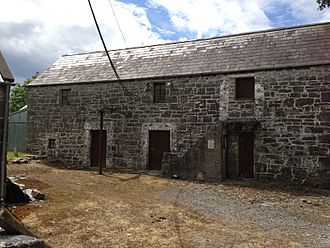Bunnadober Mill facts for kids
Quick facts for kids Bunnadober Mill |
|
|---|---|
|
Muileann Bhun na dTobar
|
|
 |
|
| Alternative names | Moran's Mill |
| General information | |
| Status | Heritage building |
| Type | Watermill |
| Architectural style | Vernacular |
| Location | Rahard |
| Town or city | Ballinrobe |
| Country | Ireland |
| Coordinates | 53°36′27″N 9°16′04″W / 53.607564°N 9.267801°W |
| Elevation | 21 m (69 ft) |
| Completed | before 1838 |
| Closed | 1980 |
| Technical details | |
| Material | slate, clay tiles, limestone, cast iron |
| Floor count | 1½ |
| Designations | |
| Official name: Bunnadober Mill Complex | |
| Reference #: | 664 |
| Renovating team | |
| Renovating firm | Howley Hayes |
Bunnadober Mill is a really old and interesting building in County Mayo, Ireland. It's a special kind of mill called a watermill, which means it used the power of a river to grind things like grain. Today, it's recognized as a National Monument, which means it's a very important historical site that the country wants to protect.
Contents
Where is Bunnadober Mill Located?
This historic mill is found in a place called Rahard. It sits right where the Bunnadober River flows. The mill is about 3.5 kilometers (about 2 miles) southwest of a town called Ballinrobe.
The Story of Bunnadober Mill
Early Days of the Mill
The mill you see today was already working by the year 1838. Imagine how long ago that was! It was first owned by a person named William Walsh. Later, around the year 1900, the Moran family took over the mill. Because of this, some people also knew it as Moran's Mill.
What the Mill Did
Mills like Bunnadober were super important in the past. They helped farmers turn their harvested grain into flour. This flour was then used to make bread and other foods. A special part of the mill, a corn-drying kiln, was added later. This kiln helped dry the corn, which was important for storing it properly.
A Unique Water Wheel
Bunnadober Mill is famous for something very special: it has a unique type of horizontal water wheel. Most water wheels you might imagine are vertical, spinning upright. But this one lies flat! It's a rare example in Ireland and shows how clever people were long ago. Experts have called it a "testament to ingenuity," meaning it proves how inventive people were. It's also seen as a "unique and very important example of industrial archaeology." This means it's a key piece of history that helps us understand old industries.
The Mill's Closing and Protection
The mill stopped working in 1980. After many years of service, it was no longer needed in the same way. In 1996, the Irish government bought the mill from the Moran family. This was done to protect it and make sure it stays safe for future generations to learn from.
What Bunnadober Mill Looks Like
The mill building is a rectangular shape. It has one main floor and a half-attic space above. The building is made up of three sections, called "bays." The Bunnadober River was the power source for the mill. Interestingly, this river starts as an underground flow from another river called the Bulkaun River.
Inside the mill, you can still find many of the old machines that were used for grinding. There's also a large collection of other items, called "artefacts," that were part of the mill's daily life. These items help us understand how people worked and lived there. The mill is built from strong materials like slate, clay tiles, limestone, and cast iron.

